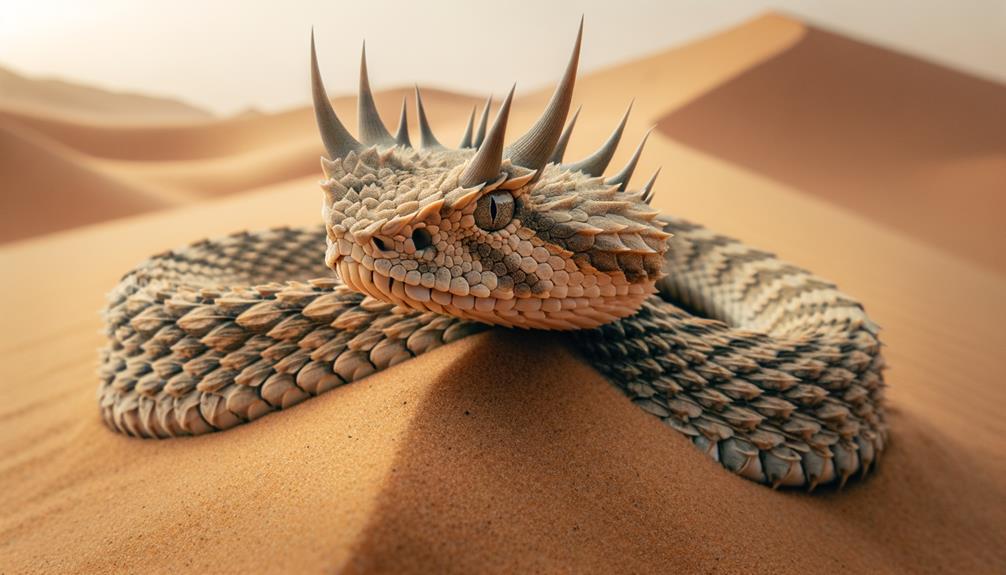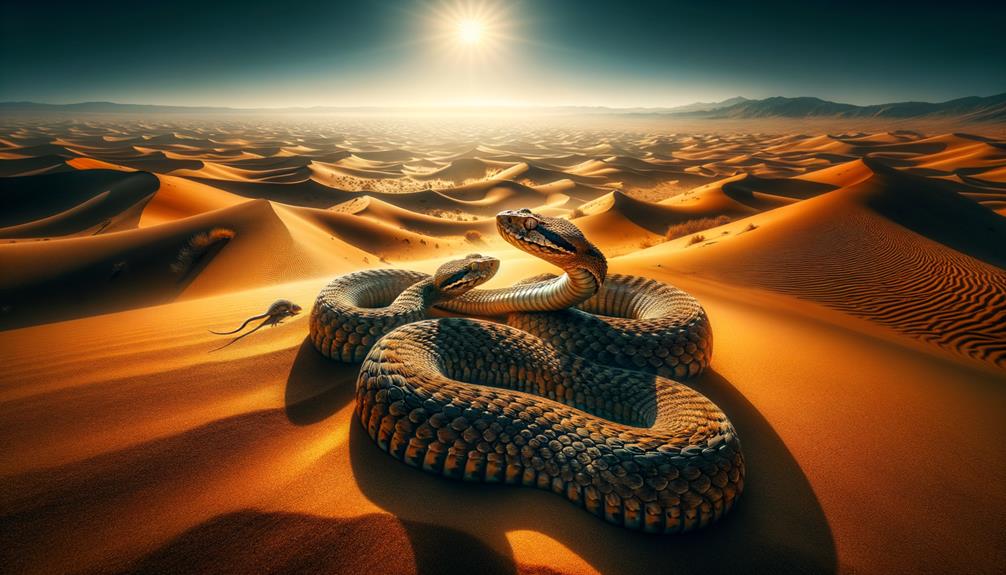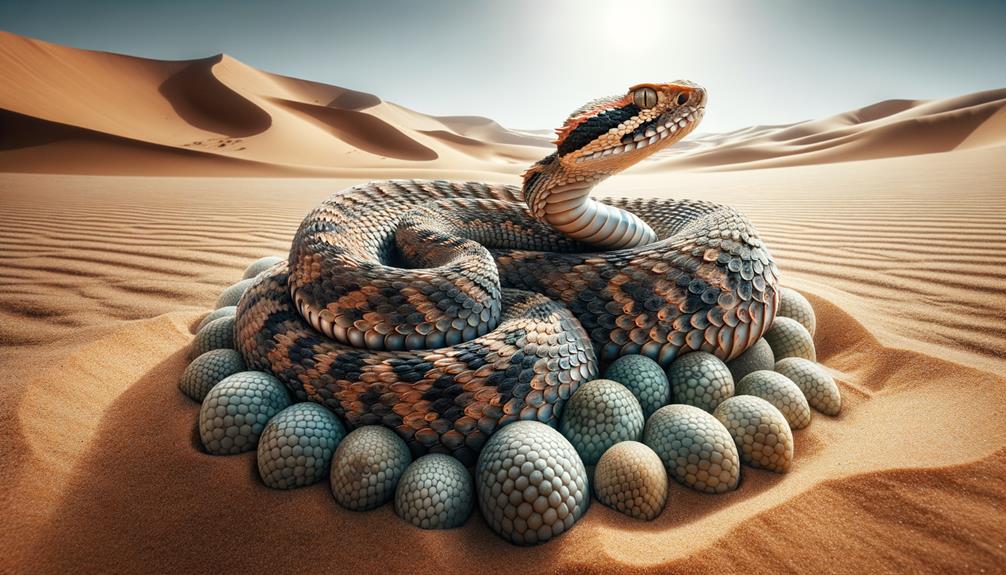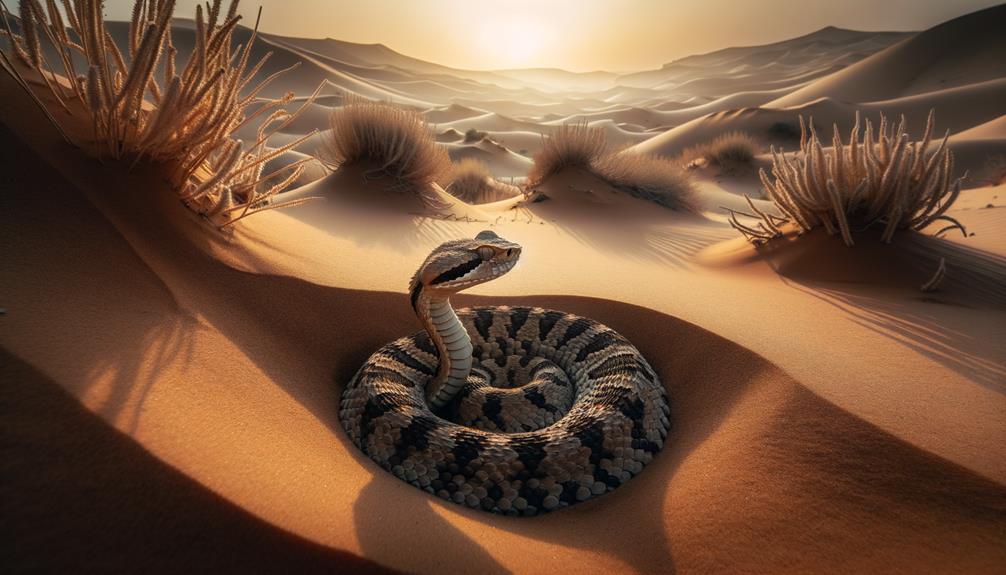The Saharan Horned Viper's ability to blend into its desert surroundings is remarkable. During my research on these snakes, I've observed how their sand-toned scales make them nearly invisible in the dry landscapes of Morocco, Algeria, and Egypt. Their eye-catching 'horns' serve a practical purpose beyond aesthetics, contributing to their survival tactics. Despite their impressive adaptations, the lack of data on their conservation status is worrying. The IUCN Red List classifies them as 'Data Deficient', which raises questions about their long-term prospects. There's still much to learn about their nocturnal hunting habits and the effects of their venom. These fascinating creatures continue to pique scientific interest and warrant further study.
Habitat and Distribution
Saharan horned vipers make their home in the dry expanses of North Africa and the Arabian Peninsula. These snakes thrive in sandy areas dotted with rocky outcrops, which serve as both hiding spots and hunting grounds. Their ability to blend seamlessly with their surroundings is remarkable, matching the color of the desert floor perfectly.
You'll find these vipers across countries like Morocco, Algeria, Egypt, Saudi Arabia, and Yemen. This range spans both the Afrotropical and Palearctic regions, showcasing how well these reptiles have adapted to the harsh desert environment.
In these arid lands, the vipers sometimes gather near oases. These pockets of vegetation and water attract potential prey, making them prime hunting spots. The scattered rocks in these areas offer crucial protection from the scorching daytime heat and would-be predators.
The Saharan horned viper's widespread presence in such challenging conditions speaks to its resilience. As the climate changes, researchers are keeping a close eye on how these adaptable creatures might shift their territories in response.
Physical Characteristics

Saharan horned vipers stand out with their distinctive eye ridges, giving them a fierce look that's almost otherworldly. These ridges aren't just for show – they help the snakes thrive in their dry habitats. The vipers' scales blend perfectly with the sandy areas they call home, ranging from pale yellows to browns.
A closer inspection reveals:
- A white underbelly that contrasts sharply with their top coloring.
- Slender tails, sometimes tipped in black.
- Male vipers have bigger heads and eyes than females, a clear sign of differences between the sexes.
- These features help them survive in the tough desert conditions.
The larger heads and eyes of male vipers make them more noticeable than females. This difference isn't just about looks – it plays a key role in how they survive and reproduce. These physical traits not only make the Saharan horned viper unique but also show how well they've adapted to life in the unforgiving desert.
Behavior Patterns

Watching Saharan horned vipers, I've noticed they prefer hunting at night when it's cooler. Their remarkable ability to blend in with the desert sand makes them excellent ambush hunters. While they can strike quickly if they feel threatened, these snakes generally maintain a calm demeanor. They rely on their stealthy nature and patience to catch their prey. Their behavior showcases a fascinating adaptation to the harsh desert environment, allowing them to thrive where many other creatures struggle.
Nocturnal Hunting Habits
The Saharan horned viper hunts at night, a clever tactic that helps it snag prey like small mammals, birds, and lizards while staying cool in the desert. This nighttime activity allows the snake to dodge the blistering daytime heat and save energy.
The viper's sharp senses are key to its success. It uses an excellent sense of smell and special heat-detecting organs to spot even the tiniest movements in the dark. Once it finds potential prey, the viper waits patiently to strike at just the right moment.
Night hunting offers several perks for the viper:
- Beats the heat: Active at night, the snake avoids scorching daytime temperatures.
- Uses its super senses: Heat detectors and a keen nose make dark hunting a breeze.
- Catches various critters: From rodents to reptiles, the viper's menu is diverse.
- Stays safe: Nighttime activity means fewer run-ins with bigger predators.
These habits show how well the Saharan horned viper has adapted to life in the harsh desert, making it a top-notch hunter in its dry home.
Camouflage and Ambush
Saharan horned vipers are masters of disguise. Their color patterns seamlessly match the sandy landscape, making them nearly invisible to prey. Those distinctive horns above their eyes aren't just for show – they help the vipers blend in perfectly with their surroundings. These sneaky snakes often bury themselves in sand or hide under rocks, ready to strike unsuspecting victims.
Their unique sidewinding movement is another clever trick. It lets them glide across loose sand without leaving obvious tracks, making it easier to sneak up on potential meals. Being night owls also works in their favor. The darkness gives them extra cover for their stealthy hunting.
All these traits – camouflage, sidewinding, and nighttime activity – make Saharan horned vipers incredibly effective hunters. They use the cover of night to their advantage, surprising prey with lightning-fast strikes. It's no wonder they've become such successful predators in the unforgiving desert environment.
Defensive Postures
Saharan horned vipers have a unique way of defending themselves. When threatened, they raise the front part of their body off the ground, forming a C-shape. This stance helps them strike quickly at potential dangers. It's a crucial survival tactic in the unforgiving North African deserts.
These snakes also coil tightly when faced with a threat. This move shields their vital organs and readies them for a fight-or-flight response. By taking this position, the viper appears bigger and more daunting. This visual trick can scare off predators and give the snake a chance to attack swiftly if needed.
Key defensive behaviors include:
- Raising the front of the body in a C-shape
- Coiling tightly to protect vital parts
- Making themselves look larger
- Striking with speed and accuracy
These aren't random actions. They're finely tuned strategies honed over time. The C-shaped stance and related behaviors form a complex defense system. It's this system that has allowed the Saharan horned viper to thrive in one of the world's harshest environments.
Hunting and Diet

When darkness falls, Saharan horned vipers come alive, showcasing their nighttime hunting skills. These desert dwellers target smaller animals like rodents, birds, and lizards with impressive accuracy. Their nocturnal habits and venomous bite make them formidable predators in their arid home.
These snakes are experts at lying in wait. They often hide under shrubs or nestle into the sand, their camouflage keeping them hidden from view. When prey wanders too close, the viper strikes quickly, its bite usually immobilizing the target in moments.
Saharan horned vipers hunt alone, relying on stealth and patience to catch their next meal. Unlike some predators that chase their quarry, these snakes know the importance of saving energy in their harsh environment. Their ability to stay motionless for long periods speaks to their survival skills and specialized hunting techniques. This nighttime activity and strategic approach to hunting help these vipers thrive in North Africa's challenging landscapes.
Venom and Effects

Saharan horned vipers pack a serious wallop with their venom, causing a range of nasty symptoms that require immediate medical care. The venom primarily attacks blood cells and vessels, leading to serious complications that can damage the kidneys. Patients bitten by these vipers often experience vomiting, tissue death at the bite site, and blood in their urine.
The venom's effects include:
- Destroying blood cells and damaging blood vessels
- Causing tissue death around the bite
- Interfering with blood clotting, leading to uncontrolled bleeding
- Potentially causing kidney failure in severe cases
Research by Schneemann and colleagues in 2004 highlighted just how dangerous this venom can be. O'Shea's work in 2008 further emphasized the venom's ability to kill tissue, stressing the need for quick medical intervention. While no human deaths have been reported, the venom's strength makes it clear that anyone bitten needs to get to a hospital fast. These bites are no joke, and understanding how bad they can be could save your life.
Reproduction and Lifespan

Saharan horned vipers have some pretty interesting breeding habits. They lay between 8 and 23 eggs in hidden spots, often tucked away under rocks or in old rodent holes. Unlike some snakes that give birth to live young, these vipers lay eggs. Mating usually happens around April, when these secretive creatures get together to reproduce. After mating, the female carefully picks a safe spot, often an abandoned rodent burrow, to lay her eggs.
The eggs take about 50 to 80 days to hatch. During this time, they're left alone, benefiting from the natural warmth and protection of their hidden nests. When the baby snakes finally break out of their shells, they're already about 12-15 cm long and ready to face the tough Saharan environment.
These vipers can start having their own babies when they're about two years old. In the wild, they typically live for several years, though exact lifespans can vary. Watching these snakes go through their life cycle really shows how tough and adaptable they are, thriving in one of the world's harshest environments.
Conservation Status

The Saharan Horned Viper's conservation status remains a puzzle. Its "Data Deficient" tag on the IUCN Red List underscores the pressing need for more research. We're in the dark about population trends, and the impact of threats like habitat loss and human conflict is fuzzy at best. The sparse conservation efforts only highlight how much we need solid studies to craft effective protection plans for these mysterious snakes. Without a clear picture, it's tough to gauge just how much trouble these vipers might be in. Scientists and conservationists face an uphill battle to fill in the blanks and ensure these unique reptiles don't slip through the cracks of our wildlife protection efforts.
Population Trends
The Saharan horned viper remains a mystery to researchers, with little known about its population trends or conservation status. Currently, the International Union for Conservation of Nature (IUCN) lists this snake as data deficient, which hinders efforts to protect it.
Key issues surrounding the Saharan horned viper include:
- Unknown population changes: Scientists can't tell if their numbers are growing, shrinking, or staying the same.
- Lack of studies: There's been minimal research and monitoring of these snakes, leaving gaps in our knowledge of how they live and reproduce.
- Unclear risk level: Without solid information, it's tough to know how vulnerable these vipers really are.
- Possible hidden dangers: While no major threats have been identified yet, the lack of data means potential risks could be lurking unnoticed.
Getting a handle on Saharan horned viper populations is crucial for creating effective conservation plans. There's an urgent need for more research and data collection to clarify their situation. By focusing on these tasks, we can quickly spot and address any emerging threats, helping to protect this unique species for years to come.
Threats and Challenges
The Saharan horned viper faces several obstacles to its survival, and grasping these issues is key to protecting this secretive snake. Currently, the IUCN Red List labels the species as Data Deficient, leaving us in the dark about its true population status. This knowledge gap makes it tough to pin down just how much trouble these serpents are in.
One of the biggest problems for the Saharan horned viper is losing its home. As people push further into the dry deserts where these snakes live, their delicate ecosystems are under threat. Cities expanding, farms spreading, and companies digging for resources all chip away at the viper's natural habitat, leaving them with fewer places to call home.
Another major issue is that people often kill these vipers out of fear or misunderstanding. This knee-jerk reaction puts even more pressure on their already struggling populations. There's no doubt that human activity is making life harder for these snakes.
Right now, there aren't many efforts to protect the Saharan horned viper. We urgently need more studies and better plans to help them. If we can tackle the problems of habitat loss and human-snake conflict, we might be able to give these vipers a fighting chance for the future.
Conservation Efforts
The Saharan horned viper faces serious challenges, and we need to ramp up our efforts to protect them. Right now, we don't have enough information about these snakes to know how they're really doing. The International Union for Conservation of Nature (IUCN) lists them as "Data Deficient," which is a fancy way of saying we're in the dark about their numbers and the full scope of threats they face.
To make sure we're not just spinning our wheels, we need to buckle down and do some serious research. Here's what's on the to-do list:
- Get boots on the ground and count these vipers.
- Figure out how habitat loss is affecting them.
- Understand how much danger they're in from people.
- Team up with folks in North Africa to find ways to live alongside these snakes.
Without this info, we're basically flying blind. We can't come up with solid plans to protect the vipers if we don't know what's really going on. By focusing on research and getting a handle on what these snakes need to thrive, we can put together plans that actually work to keep them around for the long haul.
Frequently Asked Questions
How Venomous Is a Saharan Horned Viper?
Considering the Saharan Horned Viper's venom, it packs a serious punch. When bitten, victims experience extreme swelling and queasiness, along with potential tissue damage. While no deaths have been recorded from its bite, anyone who's been struck should head to the hospital right away for treatment. It's not something to mess around with, that's for sure.
Where Does the Saharan Horned Viper Live?
The Saharan Horned Viper calls the sandy stretches and dunes of the Sahara desert and Arabian Peninsula home. These snakes thrive in dry areas with little plant life and scattered rocks. To beat the scorching daytime heat, they hide under bushes or dig into the sand.
Are Saharan Sand Vipers Poisonous?
Saharan Horned Vipers pack a potent punch with their venom. These snakes inject a toxin that attacks blood cells and tissues, causing severe swelling and damage. Interestingly, despite their dangerous bite, there are no recorded human deaths from these vipers. However, anyone bitten should seek medical help right away. The lack of fatalities doesn't mean these snakes aren't a serious threat – their venom can still cause significant harm if left untreated.
What Is the Horned Snake in Africa?
The Saharan horned viper, scientifically named Cerastes cerastes, is Africa's notable horned snake. This creature makes its home in the Sahara desert, where it's easily recognized by the distinctive horns above its eyes. As a venomous snake that's active at night, it hunts smaller animals like rodents, birds, and lizards. Its unique appearance and hunting habits make it a fascinating subject for wildlife enthusiasts and researchers alike.



